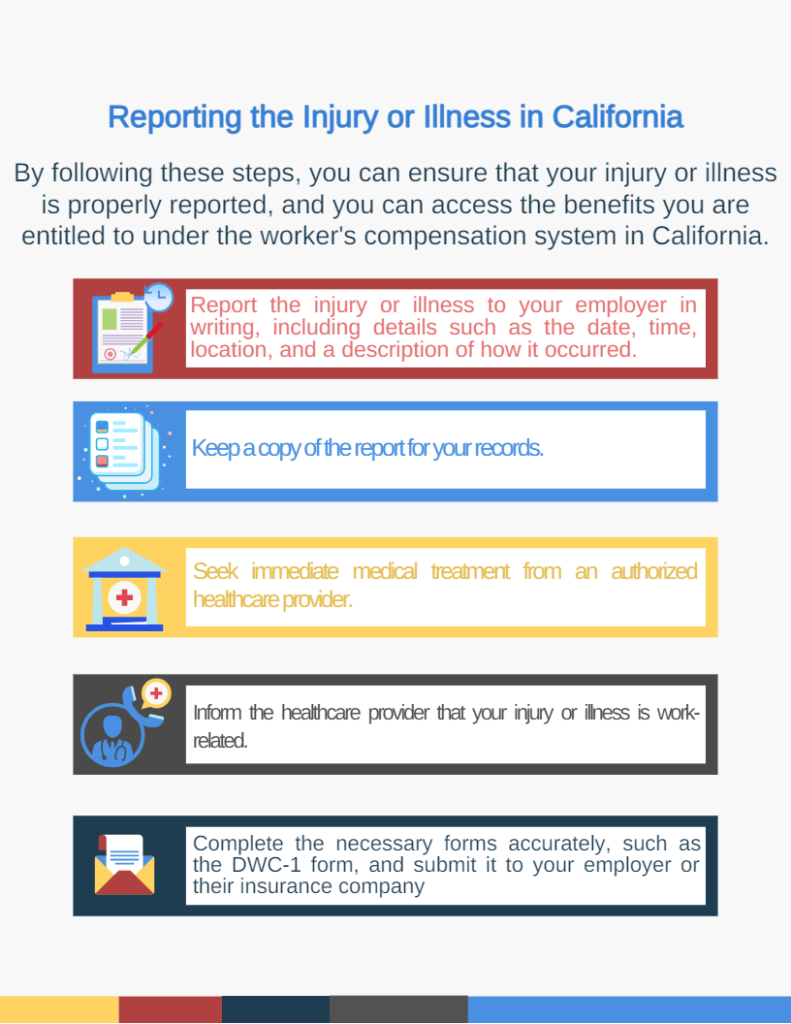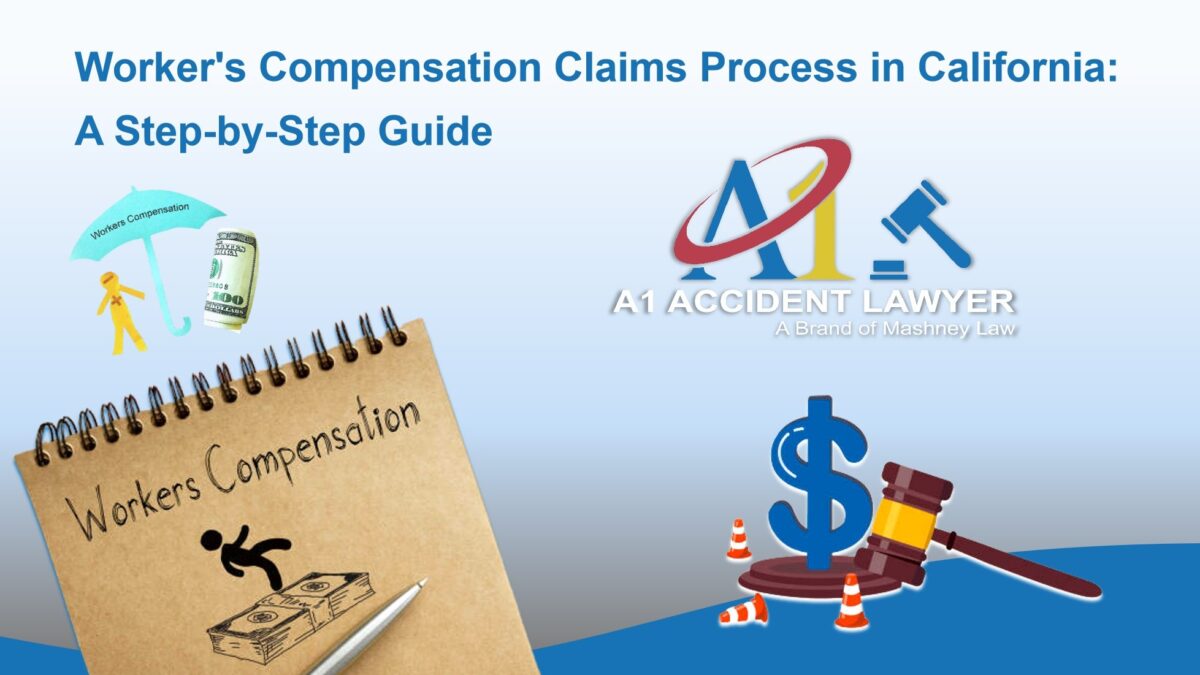The Step-by-Step Guide to Filing a Worker’s Compensation Claim in California
Introduction:
Follow our step-by-step guide to filing a worker’s compensation claim in California. From reporting the injury to resolving disputes, learn the essential steps to take for a successful claim. Discover how to navigate the claims process effectively and access the benefits you deserve in California.
Section 1: Reporting the Injury or Illness
The first step in the claims process is to report the injury or illness to your employer as soon as possible. In California, you have 30 days from the date of the injury or the date you became aware of the work-related illness to report it. It is crucial to report the incident in writing and keep a copy for your records. Include details such as the date, time, location, and a description of how the injury or illness occurred.
Section 2: Seeking Medical Treatment
After reporting the injury, you should seek immediate medical treatment from an authorized healthcare provider. In California, your employer has the right to choose the initial treating physician. Ensure you inform the healthcare provider that your injury is work-related, as this is important for billing purposes and to establish a connection between the injury and your employment.
Section 3: Completing the DWC-1 Form
Your employer should provide you with a DWC-1 form, also known as the “Employee Claim Form.” This form is used to officially file your worker’s compensation claim. Fill out the form accurately, providing all the necessary details about your injury, the date it occurred, and any medical treatment received. Keep a copy of the completed form for your records and submit it to your employer or their insurance company.
Section 4: Investigation and Decision on the Claim
Once your claim is submitted, your employer’s insurance company will conduct an investigation. They may request additional medical documentation or statements from you and your healthcare provider. The insurance company has 90 days from the date they receive your claim form to either accept or deny your claim. If they accept it, they will provide you with benefits. If they deny it, they must provide a written explanation for the denial.
Section 5: Resolving Disputes
If your claim is denied or you disagree with the decision made by the insurance company, you have the right to dispute it. In California, you can request a mandatory settlement conference, mediation, or a hearing before a workers’ compensation judge. It is advisable to seek legal representation from a worker’s compensation attorney who specializes in California law to guide you through the dispute resolution process.
Section 6: Receiving Benefits
If your claim is accepted, you may be eligible for various benefits, such as medical treatment, temporary disability benefits, permanent disability benefits, vocational rehabilitation, or death benefits. The specific benefits you receive depend on the nature and severity of your injury or illness. It is essential to keep detailed records of all medical treatments, expenses, and any changes in your condition to ensure you receive the appropriate benefits.
Conclusion:
Navigating the worker’s compensation claims process in California can be complex, but understanding the step-by-step procedure can help you protect your rights and access the benefits you deserve. Remember to report the injury promptly, seek medical treatment, complete the necessary forms accurately, and be prepared to resolve any disputes that may arise. Seeking guidance from a worker’s compensation attorney experienced in California law can provide valuable support throughout the claims process.

Tags In
-
$1,300,000.00
Auto v. Auto Personal Injury
-
$1,015,000.00
Elder Abuse
-
$825,000.00
Auto v. Auto personal injury
-
$825,000.00
Slip/Trip & Fall
-
$800,000.00
Truck Accident Personal Injury
-
$695,000.00
Industrial Personal Injury
-
$500,000.00
Drowning Personal Injury
-
$375,000.00
Elder Abuse
-
$350,000.00
Car Accident Personal Injury
-
$250,000.00
Auto Accident Personal Injury
-
$250,000.00
Truck Accident Personal Injury.
-
$250,000.00
Auto Accident Personal Injury
-
$250,000.00
Auto Accident Personal Injury
-
$230,000.00
Trip & Fall
-
$145,000.00
Auto Accident
-
$140,000.00
Personal Injury
-
$125,000.00
Bed Bug Personal Injury
-
$100,000.00
Car Accident Personal Injury
-
$100,000.00
Car Accident Personal Injury
-
$100,000.00
Car Accident Personal Injury
Natalie K
Mr. Stephen Mashney was my lawyer in a recent case. Throughout our discussions he identified all the possible outcomes in attempt to set my expectations. I recommend him for his tenacity and professionalism. I could not have forseen a better outcome. I highly recommend him… Read more “Natalie K”
Basil I
I used A1 Accident Lawyer when I had my auto accident and was very pleased with their top notch service. Mr. Mashney is a hands-on attorney who will return your calls and answer your emails promptly. His staff is very efficient and friendly. I highly… Read more “Basil I”
Evelyn C
Mr. Mashney of A1 Accident Lawyer a terrific attorney. I had to meet with Mr. Mashney regarding a construction issue regarding one of his clients. Mr. Mashney kept all his promises and the whole transaction went very smoothly. Mr. Mashney is very professional and I… Read more “Evelyn C”
Edna E
I had to deal with some legalities just recently and called up Sammy Mashney since he is just a few minutes away from my home. I have to say that I was very impressed with the customer service and quality of work he and his… Read more “Edna E”
White B
A1 Accident Lawyer is everything a law firm should be. They combine conscience with competence, principle with professionalism. When speaking Stephen Mashney you get the feeling that you are a person worthy of consideration and not just another client.”
Lyna N
Had a great experience with Mr. Mashney. He was very professional and gave me good advice. He took my concerns seriously and I appreciated him seeing me on such short notice.”
Yasser A
I strongly recommend the support of the A1 Accident Lawyer for both business and individual legal matters. within at least the past 14 years, I have never lost one case, even traffic tickets, thanks to the help of Mr. Mashney and his outstanding team. Hospitality,… Read more “Yasser A”
Fadi A
I don’t know where to start. Mr. Sami has been my Attorny for years. He is loyal, intelligent and wonderful in every aspect. He helped me and my family with our immigration status and kept his words on what he promised us. As long as… Read more “Fadi A”
Mike A
I would like to thank attorney Stephen Mashney for his exceptional work in handling my case. He and his staff were very friendly and efficient. They returned all my phone calls promptly. At the end, I was very happy with the outcome and I highly… Read more “Mike A”
Emmanuel V
I was a student in need, and Stephen resolved my problem. I was so concerned with the cost because I didn’t have any money. Out of the goodness of his heart, he didn’t charge me and even bought me lunch! Great guy and I TRUST… Read more “Emmanuel V”
Zainab E
A couple years ago I was in a car accident that was extremely life changing to the point where I had to leave my job and drop out of college for a couple of months. Natural instinct of getting in a car accident was to… Read more “Zainab E”
Cidney W
Good business, very satisfied, they always call and update you with concerns from your Case, very professional and honest”
Maria V
The best Law Office in Orange County. The staff it’s always cordial and very attentive with me all the time that I requested any information of my case. The Attorney Stephen Mashney I have the most memorable moments of cordially when for the first time… Read more “Maria V”
Adam J
Professional, helpful, honest. In the few times I have needed legal advice, the team here has gone through lengths to help me out and providing me with a full picture of the issue at hand. They have saved me money by advising me against certain… Read more “Adam J”
Sam A
A1 Accident Lawyer firm has been handling all my business legal matters since 1999. They set up my corporations, review my leases, and write up my contracts. They offer such diverse services. When my wife got in a car accident last year, we were so… Read more “Sam A”
Rusty H
Out of all the attorneys that i have had to use mr mashney is the best.when i had a problem with a renter his advice was spot on he has treated me well and did not try to get rich off me.i have recommended him… Read more “Rusty H”
Jasmina S
Mr. Mashney is the best! Definitely recommend him to anyone in need of legal help. He’s very honest and truly cares about his clients.”
Jad I
My license was suspended after I received a ticket for crossing a double yellow line on the freeway, being in the carpool by myself, and going over 65… ”
Andre A
Sam (Stephen) knows immigration laws, and the staff are very helpful and resourceful. I got a great value for the service, at a very reasonable fee – Mashney helped me submit my immigration form. The process was very smooth and went without a hitch (Thank… Read more “Andre A”
Araceli A
I have to say they are amazing. Extremely professional and helpful. I have always seen lawyers as people just out to get you for money, well this place showed me a lesson. They didn’t just do their job they went up and above the call… Read more “Araceli A”
Snehal K
Stephen and Sherie have helped me on multiple occasions with my minor legal issues. I’m grateful for their assistance.”
Nezar A
Picking a lawyer to represent you is extremely difficult. Fortunately for me, I was referred to A1 Accident Lawyer by a previous costumer of theirs. At first, being as particular as I usually am, I had my guard up with everything – making sure I… Read more “Nezar A”
April H
The A1 Accident Lawyer, did an excellent job with my case. Their team (specially Sherie) were extremely helpful, they answered all my questions & concerns. Which made the process easy. Will definitely recommend.”
Serennaa B
We came in regarding a judgment on my boyfriends credit and an order for garnishment we weren’t sure what to do I found this firm on yelp and saw good review which made me confident I had made the right choice! From the minute we… Read more “Serennaa B”
Melissa G
After I was rear-ended on the freeway and totaled my car, it was a real dilemma for me. The damn insurance company kept jerking me around and gave me false promises. I was so helpless and frustrated that I didn’t know what to do. My… Read more “Melissa G”
Berlin F
After getting into a car accident A1 Accident Lawyer helped me the whole way through. They kept me informed on my case and comfortable throughout the whole process. When it came down to my settlement I had great assistance from Aaron who made sure I… Read more “Berlin F”
Mike R
If you’ve been hurt in an accident and you are considering finding an injury claim lawyer to get any compensation you could be owed, you’ve come to the right place. A1 Accident Lawyer and his team will look after you and will give you all… Read more “Mike R”
Mohamed K
I have been looking for a legal consultation regarding a matter and i started looking online for an office to call to make an appointment. To begin with, the receptionist who answered my call was really professional and she took all info needed from me… Read more “Mohamed K”
Omar H
A1 Accident Lawyer helped me tremendously in the times I needed legal action taken. This firm has there priorities organized, and understand how important the client is. They treat their clients with the upmost respect, and fight pound for pound to make sure justice is… Read more “Omar H”
Tarek A
This lawyer is really trustworthy because he gave us the advice without knowing us. I really recommend him. He is an honest and smart lawyer. I came to him worrying that I was sued. He explained to me that I don’t have to worry about… Read more “Tarek A”
Byron C
Mr Mashney and his entire staff are the most professional and responsive team I have ever encountered in his fields of expertise! I retained his services in December 2010, and he was there for me every step of the way, until my case was completed,… Read more “Byron C”


